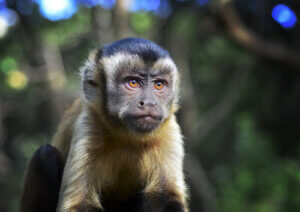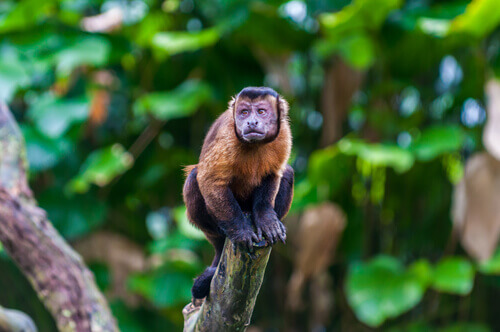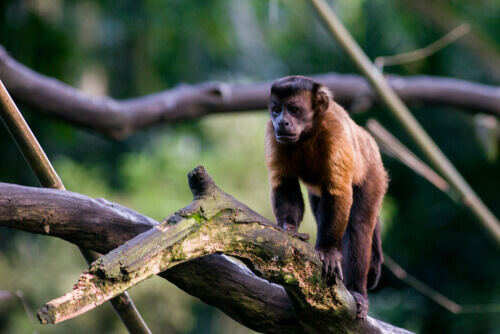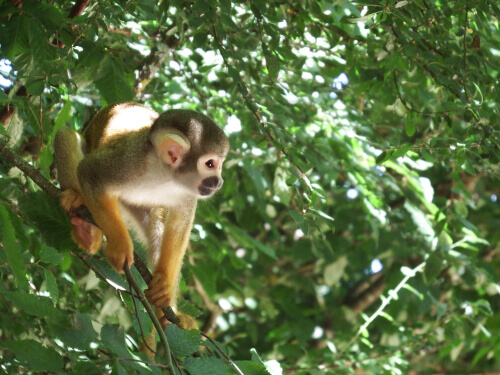Curiosities About the Black-Capped Capuchin


Written and verified by the vet Eugenio Fernández Suárez
The curiosities about the black-capped capuchin are surprising. Despite the fact that there are several species of capuchin monkey, this one is probably the most famous. Many movies and series present an unfortunate image of the black-capped capuchin, choosing to omit its surprising behavior.
Curiosities about the black-capped capuchin: a question of crests
Two of the curiosities of the black-capped capuchin refer to its crest. On the one hand, robust capuchin monkeys belonging to the genus Sapajus —to which the black-capped capuchin belongs as well— distinguish themselves by their sagittal crest, particularly in the case of males.
Normally, this sagittal crest appears in animals with a powerful bite. Lions, gorillas or even the famous and extinct tyrannosaurus are some of the animals that have a sagittal crest.
This feature seems to indicate that the black-capped capuchins have a strong bite. Additionally, they have a strong lower jaw with wide teeth, which allows them to eat hard food.
Curiously, this crest is made up of black hair, and is particularly prominent in males, especially in the alpha male. This species emits vocalizations as a means of intimidation, and arches its eyebrows, which causes the crest to move.
Destructive diet
These animals are omnivores. Most of their diet is based on fruit, roots, or plants. Nevertheless, insects, reptiles and amphibians are also part of their diet, as well as small mammals or even eggs.
But one of the curiosities about the black-capped capuchin is that it spends a lot of physical energy on feeding. It spends the day cracking nuts, breaking branches, tearing off bark, lifting rocks or chewing hard fruit.

Black-capped capuchin monkeys also know where to find all their food. Having a large brain compared to their small size allows them to have a mental map of where to find the right resources.
Curiosities about black-capped capuchin: onion baths
Bathing with onions and other materials is an almost instinctive behavior. In the wild, black-capped capuchins use lime or other citrus fruits, insects, and certain plants for bathing.
It seems that this behavior has several functions. On the one hand, bathing with these elements is antiparasitic, and repels ticks and mosquitoes. On the other, it strengthens social relationships, as capuchins gather and share onions (!) as much as possible.
The capuchin monkey, like other South American primates, has a prehensile tail, with which it can reach most of its body without problems. The tail also allows them to reach areas where they normally can’t.
Curiosities of the black-capped capuchin: use of tools
The black-capped capuchin is known for its intelligence, as one of the best examples of tool use in animals. Records show that they’re using natural containers for water, sticks to reach food, sponges to absorb liquids, and even natural hammers and chisels.
Another example is how they use stones to dig for tubers, and even prepare stones for later use by means of other stones. This behavior is common only in humans, great apes, and black-capped capuchin monkeys. This gives us an idea of their extreme intelligence.

In captivity, black-capped capuchins even use sharp rocks to cut barriers. Some scientists estimate that the black-capped capuchin monkey’s tool-using ability is similar to that of our ancestors, specifically those before Homo habilis.
Money and justice
Black-capped capuchins seem to understand the concept of money after some training. So, they understand that symbols and chips are equivalent to food and have a value. As a result, black-capped capuchins began to give food a certain value in tokens, and gave researchers what they deemed to be the correct price of the food.
These primates also understand the concept of fairness. After rewarding two black-capped capuchin monkeys with grapes and cucumber for the same task, the one awarded the cucumber would get angry at the researcher and throw it in his face.
Relationship with other monkeys
Capuchin monkeys have displayed friendliness towards other primates in the wild. Squirrel monkeys and capuchin monkeys join forces to hunt insects and obtain food. This method allows for more monkeys to watch out for predators, as both species have a common enemy: the birds of prey in the Amazon rainforest.

Moreover, researchers found that capuchin and squirrel monkeys can spend up to half a day together, even if they often sleep separately. In captivity, they also live together. Even if capuchin monkeys couldn’t enter the area of squirrel monkeys, the latter go to the capuchin monkeys’ dorm to socialize.
Curiosities about the black-capped capuchin: complex communication
Among the curiosities about the black-capped capuchin is its oral communication. This species has several vocalizations for maintaining contact between members of the group, warning calls, or even threatening calls.
They spread urine through their fur, and secretions of their chest gland, as a form of olfactory communication. This gland appears in male black-capped capuchin monkeys and seems to be related to marking.
Male capuchin monkeys engage in gatherings, where they run to hug each other while squealing with joy. This behavior hasn’t been observed in females, but researchers think its role is to strengthen group relationships.

Black-capped capuchin monkeys have great facial expressiveness, with at least seven distinct facial expressions. Like other primates, they bare their teeth in a manner similar to the human smile. However, this doesn’t indicate happiness, but aggressive threatening behavior.
An endangered species?
Studies show that, despite constant harassment, capuchin monkeys adapt very well to human company. Humans have actively exploited its ecosystem, but it’s one of the few primate species not yet at risk of extinction. In fact, it’s the most widespread primate in South America after humans.
They’ve also been captured for the film industry, entertainment, and even petting. Due to their facial expressiveness, these animals have been exploited as actors and pets. However, a monkey with clothes shouldn’t be a source of amusement, and its place is the jungle, never a house or a set.
The curiosities about the black-capped capuchin are surprising. Despite the fact that there are several species of capuchin monkey, this one is probably the most famous. Many movies and series present an unfortunate image of the black-capped capuchin, choosing to omit its surprising behavior.
Curiosities about the black-capped capuchin: a question of crests
Two of the curiosities of the black-capped capuchin refer to its crest. On the one hand, robust capuchin monkeys belonging to the genus Sapajus —to which the black-capped capuchin belongs as well— distinguish themselves by their sagittal crest, particularly in the case of males.
Normally, this sagittal crest appears in animals with a powerful bite. Lions, gorillas or even the famous and extinct tyrannosaurus are some of the animals that have a sagittal crest.
This feature seems to indicate that the black-capped capuchins have a strong bite. Additionally, they have a strong lower jaw with wide teeth, which allows them to eat hard food.
Curiously, this crest is made up of black hair, and is particularly prominent in males, especially in the alpha male. This species emits vocalizations as a means of intimidation, and arches its eyebrows, which causes the crest to move.
Destructive diet
These animals are omnivores. Most of their diet is based on fruit, roots, or plants. Nevertheless, insects, reptiles and amphibians are also part of their diet, as well as small mammals or even eggs.
But one of the curiosities about the black-capped capuchin is that it spends a lot of physical energy on feeding. It spends the day cracking nuts, breaking branches, tearing off bark, lifting rocks or chewing hard fruit.

Black-capped capuchin monkeys also know where to find all their food. Having a large brain compared to their small size allows them to have a mental map of where to find the right resources.
Curiosities about black-capped capuchin: onion baths
Bathing with onions and other materials is an almost instinctive behavior. In the wild, black-capped capuchins use lime or other citrus fruits, insects, and certain plants for bathing.
It seems that this behavior has several functions. On the one hand, bathing with these elements is antiparasitic, and repels ticks and mosquitoes. On the other, it strengthens social relationships, as capuchins gather and share onions (!) as much as possible.
The capuchin monkey, like other South American primates, has a prehensile tail, with which it can reach most of its body without problems. The tail also allows them to reach areas where they normally can’t.
Curiosities of the black-capped capuchin: use of tools
The black-capped capuchin is known for its intelligence, as one of the best examples of tool use in animals. Records show that they’re using natural containers for water, sticks to reach food, sponges to absorb liquids, and even natural hammers and chisels.
Another example is how they use stones to dig for tubers, and even prepare stones for later use by means of other stones. This behavior is common only in humans, great apes, and black-capped capuchin monkeys. This gives us an idea of their extreme intelligence.

In captivity, black-capped capuchins even use sharp rocks to cut barriers. Some scientists estimate that the black-capped capuchin monkey’s tool-using ability is similar to that of our ancestors, specifically those before Homo habilis.
Money and justice
Black-capped capuchins seem to understand the concept of money after some training. So, they understand that symbols and chips are equivalent to food and have a value. As a result, black-capped capuchins began to give food a certain value in tokens, and gave researchers what they deemed to be the correct price of the food.
These primates also understand the concept of fairness. After rewarding two black-capped capuchin monkeys with grapes and cucumber for the same task, the one awarded the cucumber would get angry at the researcher and throw it in his face.
Relationship with other monkeys
Capuchin monkeys have displayed friendliness towards other primates in the wild. Squirrel monkeys and capuchin monkeys join forces to hunt insects and obtain food. This method allows for more monkeys to watch out for predators, as both species have a common enemy: the birds of prey in the Amazon rainforest.

Moreover, researchers found that capuchin and squirrel monkeys can spend up to half a day together, even if they often sleep separately. In captivity, they also live together. Even if capuchin monkeys couldn’t enter the area of squirrel monkeys, the latter go to the capuchin monkeys’ dorm to socialize.
Curiosities about the black-capped capuchin: complex communication
Among the curiosities about the black-capped capuchin is its oral communication. This species has several vocalizations for maintaining contact between members of the group, warning calls, or even threatening calls.
They spread urine through their fur, and secretions of their chest gland, as a form of olfactory communication. This gland appears in male black-capped capuchin monkeys and seems to be related to marking.
Male capuchin monkeys engage in gatherings, where they run to hug each other while squealing with joy. This behavior hasn’t been observed in females, but researchers think its role is to strengthen group relationships.

Black-capped capuchin monkeys have great facial expressiveness, with at least seven distinct facial expressions. Like other primates, they bare their teeth in a manner similar to the human smile. However, this doesn’t indicate happiness, but aggressive threatening behavior.
An endangered species?
Studies show that, despite constant harassment, capuchin monkeys adapt very well to human company. Humans have actively exploited its ecosystem, but it’s one of the few primate species not yet at risk of extinction. In fact, it’s the most widespread primate in South America after humans.
They’ve also been captured for the film industry, entertainment, and even petting. Due to their facial expressiveness, these animals have been exploited as actors and pets. However, a monkey with clothes shouldn’t be a source of amusement, and its place is the jungle, never a house or a set.
This text is provided for informational purposes only and does not replace consultation with a professional. If in doubt, consult your specialist.








